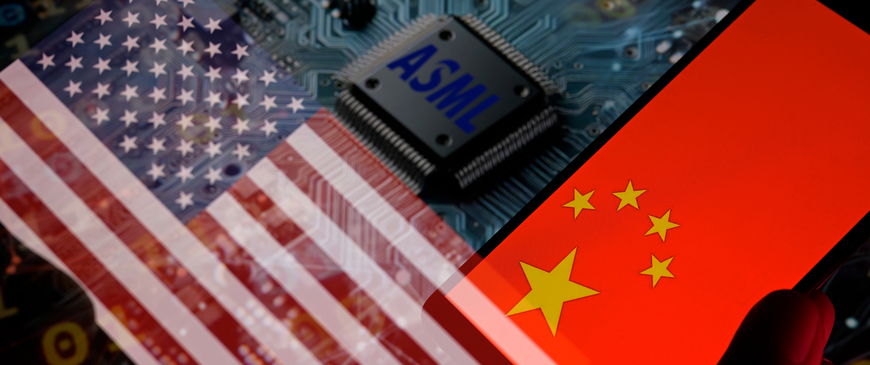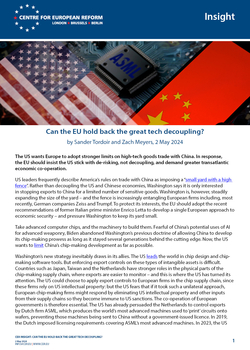
Can the EU hold back the great tech decoupling?
The US has been far more aggressive than the EU in constraining China. US leaders talk about having a “small yard with a high fence” with restrictions on trade and investment only in areas sensitive to national security. But as Washington tries to force the sale of TikTok, imposes new duties on Chinese electric vehicles, and tries to ban more chip-making exports to China, this line is becoming less plausible.
Europe has started using new tools to target Chinese firms, such as considering new tariffs on Chinese cars and launching investigations which have persuaded some Chinese firms to drop out of public procurement processes. But so far, these measures pale in comparison to US action on China – illustrating the tension between EU member-states, some of whom still have strong trade and investment ties with China.
But the EU can no longer stay on the sidelines. Take advanced computer chips, and the machinery to build them. The US has for years convinced the Dutch government to stop ASML – which has a global monopoly on machines that can print the most advanced chips – from exporting its cutting-edge machines to China.
China cannot simply replace ASML’s machines with its own because it cannot rebuild the entire ASML supply chain at once. But the US still fears that Chinese chip-makers might try to do so by acquiring inputs from ASML’s suppliers. The US is therefore looking down into ASML’s value chain, and trying to convince the German government to impose controls on exports by ASML’s suppliers like Zeiss, Trumpf and BASF. Such export controls are unlikely to dent China’s ambition to indigenise the technology now that Beijing has seen it is vulnerable regardless, but they might slow it.
US restrictions appear to be continuously expanding: getting tough on China is about the only thing Republicans and Democrats can agree on in Washington. That means the current round of negotiations is unlikely to be the last. Germany seems reluctant to acquiesce to Washington’s demands – but it may find, like the Netherlands before it, American pressure impossible to resist.
How should Europe respond?
First, as recommended by Enrico Letta in his recent report on the single market, EU members need to find strength in unity. That means more decisions about ‘economic security’ must be made in Brussels. This is necessary because export controls no longer just impact one member state: ASML’s supply chains for example run deep and wide across Europe, so the whole continent has a stake in the firm’s success. The EU needs to identify its interests as a bloc and define a clear strategy. That would it could give businesses more certainty and consistency about the rules across member-states; and it would reduce the ability of the US to lean on individual member-states. However, the EU’s recent economic security strategy failed to rise to the challenge, largely accepting member-state competences in areas like export controls and foreign investment screening and relying on voluntary mechanisms which have failed in the past.
Second, that strategy should recognise that – while both the EU and the US face security and economic risks from China – Europe’s interests are not always entirely aligned with Washington’s. For example, the EU has less demand for chip imports, especially cutting-edge ones, and should be more focused on areas like greentech where Chinese subsidies could decimate European industry.
Third, the EU should adopt a more positive form of de-risking by ensuring that the EU remains an indispensable supplier of some goods for both the US and China. To achieve this, Europe should defend, maintain and expand areas in which it still has the global lead, like production of chip-making tools. This will allow it to continue to ensure Western-aligned countries have a technological lead over China without giving up on sales to China completely, which could lower firms’ profitability and constrain their ability to invest in research and development.
Finally, the EU should use its strengthened position to negotiate a ‘club’ of like-minded and allied countries – which could help influence US policy and ensure European interests are taken into account in Washington. A ‘subsidy club’ could allow the EU and the US to agree that their industrial subsidies would be available to firms from, and activities in, all countries which meet a minimum set of standards. This would help avoid inefficient overlap in EU and US industrial policy and reduce the risks of costly overproduction.
Even if Trump wins the next US election, he would find it hard to snub a club that included many Western-aligned countries with their own chokepoints in the chip-making supply chain – and he would face significant pressure from America’s tech leaders to abide by the deal.
This strategy must be put in place now, however, while the relatively EU-friendly Biden administration is still in power. A much more hostile Trump presidency might be only eight months away. For Europe, the clock is ticking.

